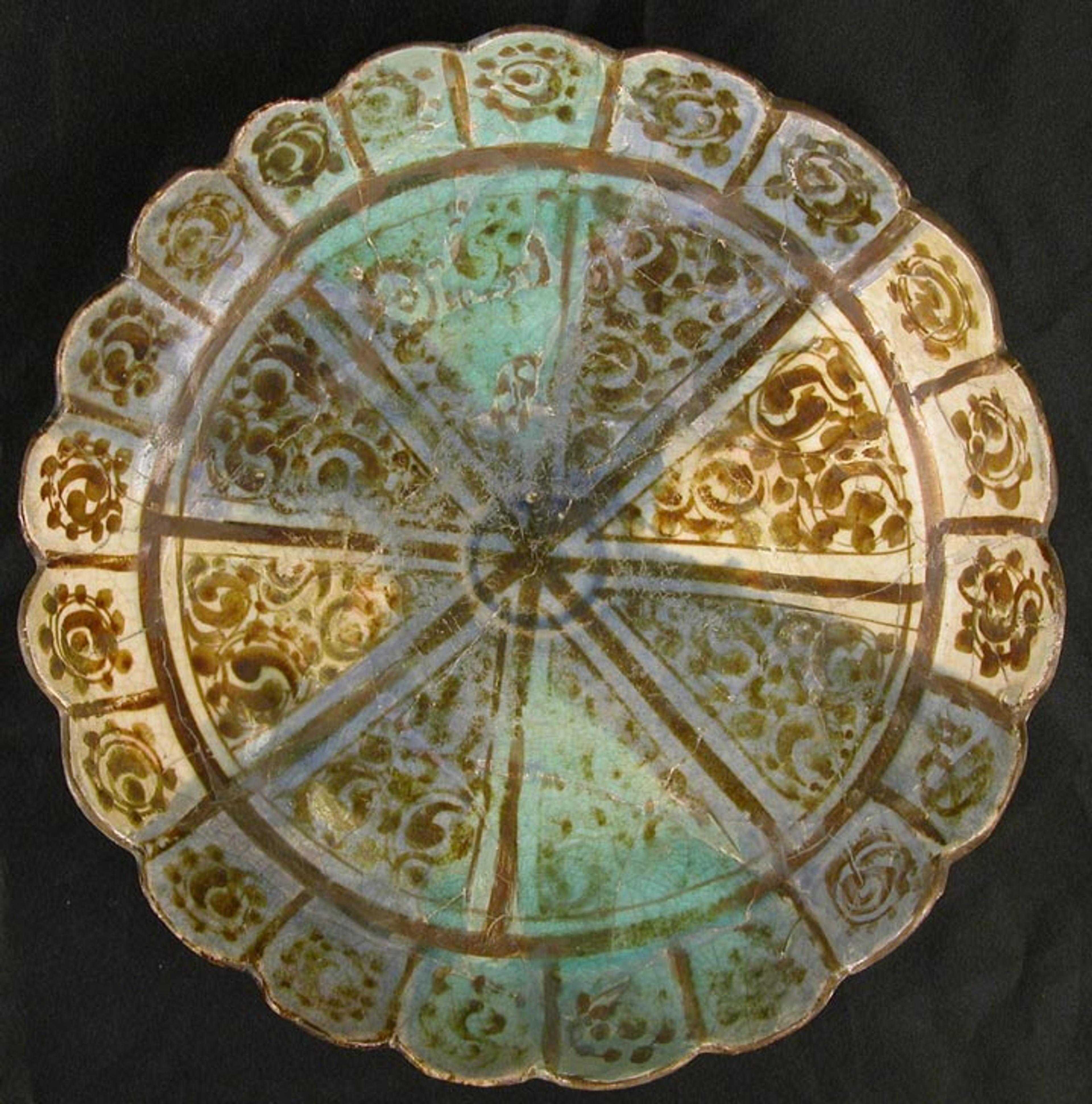
Dish with scalloped rim and radial pattern, 12th–early 13th century. Iran, probably Rayy. Islamic. Stonepaste; luster-painted, in-glaze painted, transparent colorless and blue glaze; H. 2 5/16 in. (5.9 cm), Diam. 9 1/4 in. (23.5 cm). The Metropolitan Museum of Art, New York, Rogers Fund, 1966 (66.159)
«Every work of art in The Met's collection of Islamic art has a history written in the details of its current condition. The older the piece, the more likely that it was altered or damaged and repaired in the past—sometimes more than once. An important part of a conservator's job is to trace this material history as accurately as possible, in order to determine if the provenance ascribed to an artwork—particularly its age—is correct and how much of the original fabric remains. This assessment complements the connoisseurship of curators, which is based on stylistic analysis and iconography that involves the study and interpretation of pictorial compositions and symbols.»
Through a variety of lighting sources—including natural, ultraviolet, infrared, and X-rays—digital imaging provides very effective tools for conservators to determine and convey accurate information about the condition of objects to curatorial colleagues. This information can then be used to make informed decisions about whether or not an object is intact enough to meet the Museum's standards for exhibition and whether or not it would benefit from treatment.
Digital imaging has the advantage of being essentially noninvasive, meaning that information can be obtained without altering the work of art. In addition, we can manipulate the digital image files to reveal specific aspects of the objects under examination and how they might look following different treatment scenarios. In preparation for the reinstallation of the galleries of the Department of Islamic Art in 2011, many of the ceramics in that collection were photographed under natural and UV light, and radiographed before the final display list was compiled and conservation work was begun.
Given that over seven centuries have passed since the Seljuq period (1038–1307), it is not surprising that many objects produced during that time have suffered both chemical alterations and physical damage. In fact, if an artwork attributed to this period did not display any genuine signs of age-related changes, conservators and curators would be very suspicious of its authenticity! In preparing for the exhibition Transformed: Medieval Syrian and Iranian Art in the Early 20th Century, on view through July 17, curator Martina Rugiadi selected a number of ceramics whose appearance was unusual or suspicious. As documented in the video below, in which the same view of an object alternates between natural and UV light, the modern alterations revealed during the examination were visually striking. In some cases, radiographs provide additional information.
When illuminated by UV light, which has a higher energy than natural light, some materials such as adhesives and the binders used in paints will absorb energy in the form of a photon of light for a brief period of time before returning to their normal or relaxed state. When they return, photons are released, which results in a fluorescence that can be perceived by our eyes as well as by cameras. Sometimes the color of the fluorescence can provide information about the material that is present; for example, modern adhesives often have a greenish-yellow fluorescence, while shellac has a bright orange glow.
Sometimes past restorers applied paint on both restorations and original surfaces in order to obscure the difference between both surfaces. Radiographs allow us to peer through this paint and determine if the material below is ceramic or plaster. This same technology also allows us to see if the edges of old fragments were sawn or filed down in order to fit into lost areas of similar vessels.
As the above video demonstrates, old ceramics may not always be as well preserved as they appear to the unaided eye. While the art market provided a financial incentive to make them appear to be intact, we should not assume that the excessive restoration treatments of the past were always duplicitous in intent. In some cases, dealers, collectors, and restorers were simply trying to recreate the ambiance of the past using the fragments at their disposal.
Related Link
Transformed: Medieval Syrian and Iranian Art in the Early 20th Century, on view at The Met Fifth Avenue through July 17, 2016